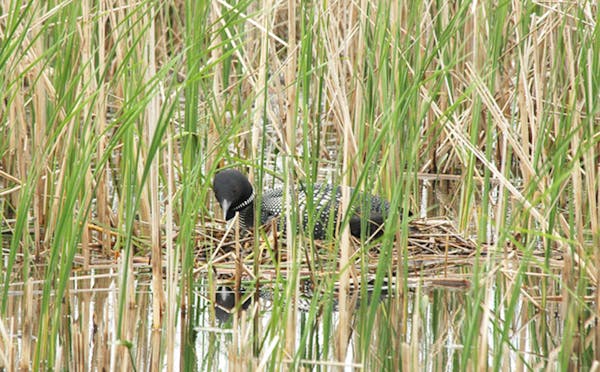Peter Jacobson was studying a particular kind of oily white fish when he started noticing the loons. The birds, which in Minnesota are almost only ever seen in pairs or small family units, were gathering by the dozens, forming groups of more than 100 on a handful of Minnesota's deepest and clearest lakes.
The loons didn't spend much time in shallow waters, Jacobson noticed. They rafted together over the deepest parts of the lakes — directly over the schools of cisco that the now-retired fisheries expert for the Minnesota Department of Natural Resources was studying.
"That raised my suspicion," Jacobson said.
He spoke with Kevin Kenow, a loon expert with U.S. Geological Survey. Kenow led a study published this spring that confirmed Jacobson's hunch: Loons start to converge in the late summer on Minnesota's cisco lakes, just before their migration. They give up fighting each other for territory and prey, and fish as a group. And what they primarily fish for is cisco.
"They are a grade A forage fish," Jacobson said. "They're high-energy, high-fat, very oily, so it made sense that loons would want to go after them before they migrate."
The annual phenomenon typically begins in late August. Loons show up in pairs or alone, building up larger and larger numbers on waters such as Upper and Lower Whitefish lakes, on Lower Hay and Kabekona lakes, on Ten Mile Lake and dozens of others across central and northern Minnesota.
Adult loons will continue gathering on the lakes until they leave the state in early October.
Cooperation can seem like odd behavior for the highly territorial birds, who spend so much of their time in spring and summer alone with their mate and offspring. But now is the time they need to focus on a common goal — building up energy for their trek to southern Florida, Kenow said.
"It seems like finding the school of cisco and keeping up with it is easier to do with a larger number of birds foraging together," Kenow said.
While cisco are rarely sought out by anglers, they have long been known to have an outsized impact on the quality of fishing in Minnesota. The state historically had about 650 cisco lakes. The DNR expects that to fall to fewer than 200. Rising temperatures, less ice coverage and more nutrients from agricultural runoff are starving many of the state's lakes of oxygen, killing off cold-water loving fish like cisco and lake trout.
Those lakes that still have cisco also have bigger, stronger and healthier walleye, muskie and lake trout populations.
Cisco, the new study shows, are highly beneficial to the state's most beloved bird as well.
The seasonal phenomenon also sheds new light on one of the strangest migration paths of any Minnesota animal. Soon, adult loons will depart the state's cisco lakes, leaving their young offspring behind. The adults will head to Lake Michigan, where they will gather by the thousands with other loons from Canada and the Upper Midwest. They'll spend about 28 days on the Great Lake, feasting on invasive round gobies and other small fish, Kenow said.
Then they'll shoot off together for their wintering grounds either on the Gulf of Mexico or Florida's Atlantic coast.
Young loons will stay in the lakes where they were born.
While their parents pack on needed calories on Lake Michigan, the juveniles get their first chance to enjoy a lake to themselves. They seem to know those waters well enough by then to forage on their own, Kenow said.
Then something will click, right around November in the yearling birds. Nobody teaches them where to fly, but they all head straight for southern Florida.
"I've radio marked loon chicks that were 10 weeks old and I was able to see their location every morning," Kenow said. "I felt like a dad waiting for his teenagers to come home at night. It was getting into November and they weren't leaving."
Finally, just before the lake iced over, the young birds left.
"It's just innate," he said. "They have this compass bearing in mind and that's what they seem to follow."
In spring, the adults will try to return to the same lake where they raised their young the last year. The juveniles, however, will typically fan out across great distances to find breeding lakes of their own and those born in Minnesota may never return.

Want to share info with the Star Tribune? How to do it securely

'Safe recovery sites' would offer syringes, naloxone and more to people using drugs. The plan could be in peril.
New Minnesota GOP leaders seek peace with party's anti-establishment wing

Who is Republican Lisa Demuth, Minnesota's first House speaker of color?

